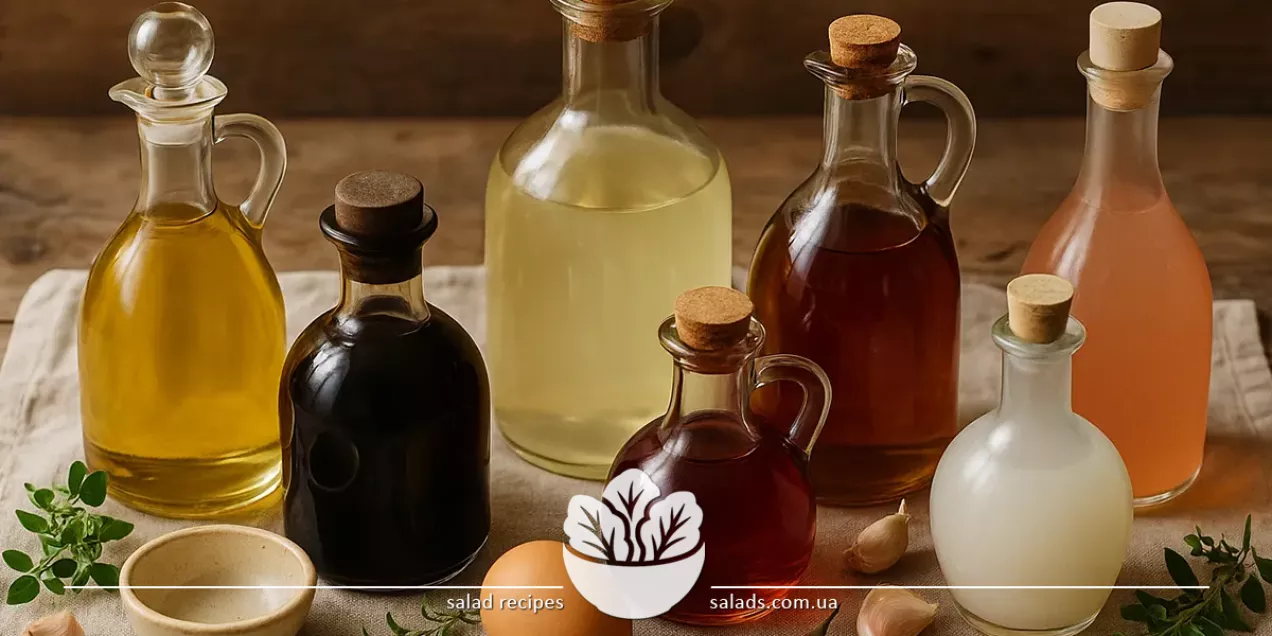Types of Vinegar

Types of vinegar cover a wide range of natural and synthetic varieties used in cooking to add acidity, enhance flavor, and balance dishes. Vinegar can be fruit-based, grain-based, fermented, or chemically synthesized – each type has its own culinary application and unique flavor profile. Within the sauces category, vinegar stands out with the highest acidity and the broadest range of options: from delicate balsamic to sharp table vinegar.
Different Types of Vinegar
Apple, Wine, Balsamic, and Other Types of Vinegar
There are many varieties of vinegar, each with its own unique properties, aroma, and culinary uses. The most commonly used at home is table vinegar – a solution of acetic acid with a pronounced sour taste, mainly used for preservation, cleaning, or quick marinating. Its taste is quite sharp, which is why in modern gastronomy, natural varieties are increasingly preferred. Apple cider vinegar is made by fermenting apple juice or cider. It has a mild sweet-and-sour flavor and a rich aroma. Due to its natural origin and mineral content, it is often used in healthy diets – for salad dressings, beverages, marinades, or sauces. It pairs well with honey, sugar, and mustard, especially in light vitamin-rich dishes.
Wine vinegar is divided into white and red types. White vinegar has a more delicate flavor and is suitable for salads with fresh vegetables or fruits, while red vinegar is more intense, with a pronounced aroma of grape skins, making it ideal for meat marinades, stews, or flavoring soups. Both types are produced through wine fermentation and are commonly used in Mediterranean cuisine. Balsamic vinegar is one of the most refined. It is made from reduced grape must that is aged for years in wooden barrels. As a result, it has a dark color, thick consistency, and a rich sweet-and-sour taste. This vinegar is suitable not only for meat and vegetables but also for fruits, ice cream, or cheese – for example, in combination with apples or pears. Other popular types include rice vinegar (mild, almost sweet, widely used in Japanese cuisine) and coconut vinegar (exotic, less acidic, with a light tropical note). Thanks to this variety, vinegar can satisfy the most demanding tastes and find its place in any recipe.
Composition, Acidity, and Benefits of Vinegar
The base of any vinegar is acetic acid, which is formed during the fermentation of carbohydrates – sugars, alcohols, or fruit juices. The acetic acid concentration usually ranges from 4 to 6% for culinary use, while in some types (such as table vinegar) it can reach 9%. This acid is responsible for the characteristic sour taste and the product’s preservative properties. High-quality natural vinegar also contains other organic acids, enzymes, minerals, and even antioxidants. For example, apple cider vinegar retains some B vitamins, potassium, pectin, and polyphenols – making it popular not only in cooking but also in fitness diets and detox programs.
Vinegar has pronounced antibacterial properties, inhibits the growth of microorganisms, and extends the shelf life of foods. It is added to marinades for meat, fish, and vegetables not only for flavor but also for disinfection. Due to its acidity, vinegar softens proteins, making the texture of dishes more tender. For example, it works well in marinades for wheat bread with additions – adding a pleasant tanginess. Vinegar can also improve the absorption of iron from plant-based foods and stimulate appetite. Its acidity promotes the production of gastric juice, which positively affects digestion. However, excessive consumption or the use of low-quality vinegar may irritate the mucous membrane, so it is important to use it in moderation and choose trusted types. Another important factor is that natural vinegar always indicates its product origin (apple, wine, rice, etc.), whereas synthetic vinegar is a water solution of acetic acid without additional nutritional value. For daily consumption, it is advisable to choose natural varieties.
Culinary Uses of Different Types of Vinegar
Vinegar is a multifunctional ingredient used in cooking for dressings, marinades, baking, glazing, and even desserts. Its acidity helps balance fat, sweetness, or bitterness, and also enhances the taste of other ingredients. In salad preparation, wine, apple cider, or balsamic vinegar are most often used – they are mixed with oil, mustard, or honey to create a flavorful dressing. In marinades, vinegar performs several functions at once: it disinfects, softens the texture, and adds a characteristic aroma. For example, apple cider vinegar is often used to marinate chicken or pork, while rice vinegar is common in Asian dishes, especially paired with shrimp or vegetables. Darker vinegars, such as balsamic, are suitable for roasting or stewing meat as well as glazing roasted vegetables.
In baking, vinegar acts as a natural leavening agent, reacting with baking soda and producing carbon dioxide. It is often included in dough for shortbread cookies, muffins, or pies. The combination of table or apple cider vinegar with soda is especially popular in egg-free recipes. Vinegar is also used in vegetable preservation – cucumbers, tomatoes, peppers. Its acidity inhibits bacterial growth and prolongs shelf life. Table or apple cider vinegar, with sufficient strength and a neutral taste, are usually used for such purposes. A refined application is in desserts, where balsamic vinegar can emphasize the flavor of fruits, ice cream, or cheese. In the right proportions, it is added to caramelized pears, berry toppings, or even chocolate sauces. Combined with pepper, balsamic vinegar creates unusual gastronomic contrasts that reveal new layers of flavor.
How to Store Vinegar Properly
Vinegar is one of the most stable products in the kitchen. Thanks to its acidity, it almost never spoils, even during long-term storage. Most types of vinegar – especially table, apple cider, or wine – can be stored at room temperature in a dark, dry place – such as a kitchen cabinet. The bottle should be tightly closed to prevent evaporation and oxidation of the aroma. Vinegar has an almost unlimited shelf life, although some natural varieties – such as unfiltered apple cider vinegar – may become cloudy or form sediment over time. This is not a sign of spoilage but an indication of its natural origin. Such types are best stored in the refrigerator, especially after opening, to preserve their flavor and aroma. Balsamic vinegar is best stored in dark glass, away from metal and sunlight. Its intense flavor and complex structure may change over time – but with proper storage, it retains its properties for years. If the bottle is tightly closed, balsamic vinegar can even be stored outside the refrigerator.
Flavored vinegar – with herbs, spices, or honey – has a slightly shorter shelf life. After opening, such types should be kept in the refrigerator and used within 1-3 months. For example, vinegar with added sugar or fruit juice may change its taste during prolonged warm storage. By storing vinegar properly, you preserve its flavor, aroma, and beneficial properties. This is especially relevant for natural varieties used in haute cuisine or as part of health-conscious diets.
Vinegar in Healthy Eating and Everyday Diets
In moderate amounts, vinegar can be a beneficial component of a healthy diet. Its acidity stimulates digestion, improves appetite, and aids in the absorption of nutrients – especially iron from plant sources. Some types, such as unfiltered apple cider vinegar, contain probiotics, enzymes, and organic acids that support gut microbiota. Vinegar is also often used in detox programs: a mixture of 1 teaspoon of apple cider vinegar with warm water and honey is considered a folk remedy for balancing pH levels. Although scientific evidence supporting such practices is limited, consuming high-quality vinegar in your diet certainly won’t harm – provided there are no contraindications, such as ulcers or high stomach acidity.
Vinegar’s low calorie content (an average of 2-5 kcal per tablespoon) makes it an ideal ingredient for salad dressings, marinades, and sauces. It helps reduce excess salt, soy sauce, or fats, enhancing the flavor of a dish through its natural tang. For example, combined with wheat bread, herbs, and oil, vinegar creates a classic Mediterranean combination. Vinegar also acts as a natural preservative – without artificial additives. It is used for home vegetable canning, preparing long-lasting sauces, and appetizers. In traditional cuisines of many countries, vinegar is an essential ingredient in ferments, cold soups, stews, and fried dishes. As a result, choosing the right vinegar helps not only to diversify your menu but also to make it more balanced and healthy. Natural types of vinegar – especially fruit and wine-based – enrich flavor and bring new dimensions to familiar recipes.
